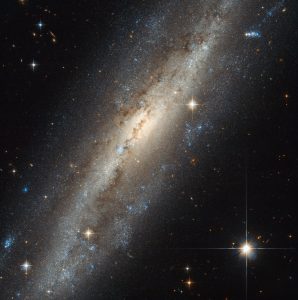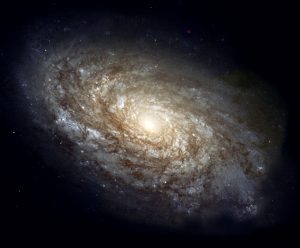Galaxies come in all shapes and sizes. The smallest contain a few million stars, the largest a trillion or more. Some contain only old red and yellow stars and are relatively quiet, while others are blazing stellar factories of young blue and white stars.
There are three basic shapes: spiral, elliptical, and irregular. But within this simple grouping there are many variants. Identifying a galaxy type is not easy. Apart from the vast distances involved we do not always see a clear profile of the stellar grouping. A galaxy may appear a flat disc while another may look like a wheel because it is rotating at right angles to our plane of sight. And in neither case do we have more than a two-dimensional view.
Aside from the three basic types mentioned, some galaxies are sub-grouped as barred, lenticular, spherical, ring, flocculent, and starburst. Some candidates are in the process of merging or interacting. There is indeed a great diversity.
Spiral galaxy
A spiral galaxy is a vast rotating disc of stars, dust and gas that have a ball-shaped nucleus inside a disc with spiral arms. Spiral arms are a common feature of disc-shaped galaxies. Spiral galaxies are the most common type in the universe, making up 60% to 75% of all galaxies in the observable universe.
The central bright region at the core of a galaxy is called the “galactic bulge”. Many spirals have a fainter halo of stars, many of which reside in globular clusters arrayed above and below the disc.
The spiral arms are sites of ongoing star formation and are brighter than the surrounding disc because of the young, hot stars that inhabit them.
Subgroups of spirals are defined by the characteristics of their bulges, spiral arms, and how tightly wound those arms are.
Examples: Andromeda Galaxy (M31). Sombrero Galaxy (M104). Triangulum (M33). Bode’s Galaxy (M81). Black Eye Galaxy (M64). The Whirlpool Galaxy is a pair of galaxies, NGC 5194 is a spiral galaxy and NGC 5195 is its partner, a smaller irregular galaxy. The Pinwheel Galaxy (M101/NGC 5457) is at 27 million light years distant. Being face-on its spirals are clearly seen. NGC 4038 and NGC 4039 are two disrupted spiral galaxies that have been in collision for the last 700 million years. The Mice are catalogued as one galaxy under NGC 4676 but are in fact a pair of colliding spiral galaxies. Their white “tails” are spiral arms unwinding during the collision.

Barred spiral galaxy
Spiral Galaxies that have a bar-like structure that extends from the central bulge are called “barred spirals”. Roughly two-thirds of all spiral galaxies have these bars, at the ends of which the spiral arms begin. Our very own Milky Way is a barred spiral galaxy.
It is believed that the proportion of barred spirals relative to barless spirals has changed over the history of the universe. Only 10% of spiral galaxies contained bars about 8 billion years ago; roughly a quarter had bars 2.5 billion years ago; and today over two-thirds of the spiral galaxies in the visible universe are barred spirals.
Examples: The Tadpole Galaxy (UGC1024). The Great Barred Spiral Galaxy (NGC 1365). Condor Galaxy (NGC 6872) is a massive galaxy in the Pavo Constellation. NGC 4921 in the Coma Cluster.
Elliptical galaxy
Elliptical galaxies are the largest type of galaxies. They range in shape from nearly spherical to nearly flat, although many having the appearance of a squashed ball. Elliptical galaxies are found largely in galaxy clusters and smaller compact groups. They can range in size from a few thousand light-years across to more than a few hundred thousand light years across. And they can contain as many as a trillion stars.
Almost all the stars in elliptical galaxies are yellow or red stars, and there is little evidence of gas and dust in the interstellar medium. Because of this there is nothing to flatten the stars into a single plane of rotation, so they tend to form a more spherical shape. Indeed, the largest galaxies of this type are always very close to a perfect sphere.
This dominance of older, low-mass stars indicates that star-forming activity has long since ended. Stars in elliptical galaxies are very widely dispersed so the chances of collision is very remote.
Astronomers now suggest that every elliptical galaxy has a central supermassive black hole.
There are some subgroups of ellipticals, including “dwarf ellipticals” with properties that put them somewhere between regular ellipticals and the tightly knit groups of stars called globular clusters. These contain but a few million stars, often loosely distributed, and appearing faint and diffuse. Dwarf ellipticals are the most common type of elliptical galaxy.
The class of an elliptical galaxy is found first by working out the difference between its long and short axes; then divide the answer by the long-axis length and then multiplying by 10. So, for example, M110 is therefore a class E6 galaxy. The dimensions are measured in arcminutes.
Examples: Centaurus A. Fornax A (NGC 1316) is a dusty elliptical galaxy. Hercules A is a giant elliptical 1.5 million light years in diameter. M87 is another giant elliptical galaxy, almost one million light years in diameter. M49 is a giant elliptical of type E4. It has a diameter of about 160 000 light years. Some astronomers class it as an “intermediate galaxy” because its mass is a lot less than the true giants. M60 is one of the giant elliptical galaxies in the Virgo galaxy cluster, the central cluster in our own Local Supercluster of galaxies. As an E2 class it is very nearly spherical.
Lenticular galaxy
These are intermediate galaxies that exist between the spiral and elliptical types.
Lenticular galaxies, like ellipticals, are dominated by old red and yellow stars. Their unique feature, however, is a disc of stars and dust rotating about the nucleus. They have a bulge in the centre, much larger than the spiral variety, but no spiral structure to speak of. Lenticulars show little sign of star-forming activity in their discs. Because they largely contain red and yellow stars like ellipticals they are also poorly illuminated and difficult to distinguish from elliptical galaxies. Indeed, face-on they might be wrongly classified as ellipticals. Spiral galaxies edge on are sometimes wrongly classified as lenticular. So it is not easy.
Astronomers are not sure how lenticular galaxies form and suggest they may be old spiral galaxies that have lost most of their dust and gas.
Examples: The Cartwheel Galaxy (ESO 350-40) is also a ring galaxy. NGC 2787 is one of the closest lenticular galaxies with dust lanes clearly silhouetted against its nucleus. Another is the Spindle Galaxy (NGC 5866). It is edge-on as viewed from Earth so any spirals it might contain cannot be seen and it is taken as the lenticular type.
Dwarf Galaxy
A dwarf galaxy is—well—small. The Leo I is a nearby dwarf elliptical. With so few stars in it there must be a lot of dark matter gravity keeping it together. Another example is the Sagittarius Dwarf Elliptical, sometimes abbreviated SagDEG. Until 1994 it was considered our closest galaxy. Canis Major Dwarf now has that honour.
Irregular galaxy
The irregular galaxy is essentially all the rest. These galaxies are often small and do not have enough gravitational force to organise them into a more regular form. Irregular galaxies can also be large galaxies that have undergone a major gravitational disturbance. Irregulars usually have vast hydrogen emission nebulae where star formation is taking place.
The Large Magellanic Cloud and the Small Magellanic Cloud are good examples of irregular galaxies.

Other irregular types are:
- Starburst galaxy. Many irregulars are “starburst” galaxies, which have great waves of star formation sweeping through them. Starburst Galaxy NGC 908 is also an unbarred spiral. Another example is the Cigar Galaxy (M82). It is undergoing an intense period of star birth following an altercation with Bode’s Galaxy.
- Ring galaxy. A ring galaxy is the result of a cosmic collision of a spiral galaxy with a smaller galaxy. A good example is AM 0644-741, a circle of a bright star-forming region about 300 million light years from earth. Also Hoag’s Object in the Serpens Constellation. M82 is an irregular starburst galaxy crossed with dark dust lanes.
- Flocculent galaxy. A flocculent galaxy is a sub-type of a spiral galaxy where the spiral arms are poorly defined and indeed look “fluffy”. NGC 4414 is a flocculent unbarred spiral galaxy lying at 62 million light years distant in the Constellation Coma Berenices. The spiral segments are very short. M33 is an example of a flocculent spiral galaxy. Its arms divide like split ends and separate into patches.
- Polar ring galaxy. This type is probably formed by collision. NGC 4650A, for example, is a blue-white star-forming ring which extends from the nucleus and is aligned with the poles.
- NGC 4449 is an irregular galaxy that lacks structure but includes chains of young stars and dark clouds. It is 12 million light years distant.
Back to Top
By Nigel Benetton, science fiction author of Red Moon Burning and The Wild Sands of Rotar.
Last updated: Monday, 22 March 2021